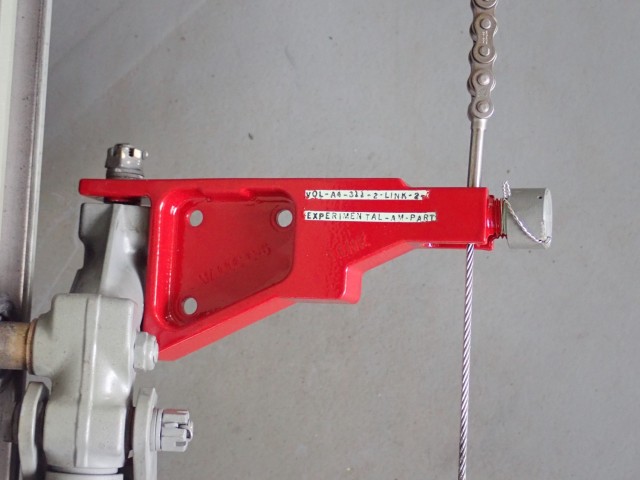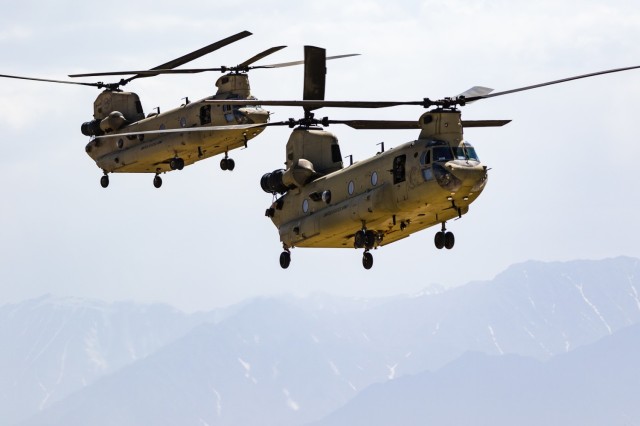El problema/oportunidad: fallas en los componentes metálicos conocidos como eslabones de rampa de carga que están instalados en los Chinook. Un componente de aeronave defectuoso es malo, pero no poder obtener componentes de reemplazo del fabricante del equipo original en pequeñas cantidades plantea un desafío adicional. La solución: el programa AMNOW (abreviatura de Additive Manufacturing Now) del Centro Nacional de Fabricación y Mecanizado de Defensa.
REDSTONE ARSENAL, Ala. (Oct. 20, 2022) – What is a problem, if not an opportunity?
That’s the mindset of the talented engineers at the U.S. Army Combat Capabilities Development Command Aviation & Missile Center and partner organizations across the Army aviation enterprise who recently solved a problem for the Warfighter and achieved an Army first while at it.
The problem/opportunity: failing metal components known as cargo ramp links that are installed on Chinook aircraft. A failing aircraft component is bad but being unable to source replacement components from the original equipment manufacturer in low quantities poses an added challenge.
“I’m sure the original equipment manufacturers are nice people, but they don’t want to set up their forge to make exactly three parts as the Army breaks them,” said Jeffrey Gaddes of AvMC’s Aviation Manufacturing Technology office. “So, they do economical lots and buys. Which makes sense from their perspective, but from the Army perspective it doesn’t always help us out.”
The solution: the varied team of collaborators behind the National Center for Defense Manufacturing and Machining’s AMNOW – short for Additive Manufacturing Now – program.
“So how does the Army go from saying, ‘Hey, I’ve got this 2D drawing of a part’ to, ‘I need a part to solve a readiness problem right now,’ and that was the whole point of AMNOW,” explained Gaddes.
It was former Command Sergeant Major of the U.S. Army Aviation and Missile Command George “Mike” Dove who identified the failing cargo ramp links opportunity and AMNOW was ready to deliver a solution.
AvMC was responsible for the contract, requirements, and oversight under which the hardware was produced. After several cargo ramp links were printed, using cutting-edge Laser Powder Bed Fusion from 7A77 aluminum alloy powder, the U.S. Army Redstone Test Center machined and tested the links to confirm their strength, preparing them to be installed on an aircraft.
The installation and flight of two cargo ramp links represents the first Army-developed metallic additively manufactured parts to be flown on Army aircraft without original equipment manufacturer involvement.

Nothing flies on Army aircraft that isn’t certified by AvMC’s airworthiness engineers who are conveniently nested under AvMC’s Systems Readiness Directorate alongside the Aviation ManTech office.
“SRD has to be involved when making changes to aircraft since they are the delegated airworthiness authority,” Gaddes said. “People using these aircraft could potentially be under hostile fire. They don’t want to worry about falling out of the sky because their aircraft fails. SRD has a very important role and they’re very heavily involved in the additive manufacturing work we’re doing on behalf of AMCOM.”
The cargo ramp links are installed and flying but that’s not the end of this first-for-the-Army story. That’s just the end of phase one of the project.
AvMC SRD Liaison Engineer Travis Massa, who is stationed at Fort Campbell, Kentucky, has been on the ground assisting the cargo ramp links project to make sure the links had the appropriate authorizations to fly.
“Phase two of the project will develop a new link that will be made from titanium. This new link will be redesigned to address the inherent design issues of the legacy link and optimize the design for AM,” Massa said.
The aluminum cargo ramp links were intended as a proof of concept. AMCOM is funding the project to make the links out of titanium, which is stronger than aluminum.
“All stakeholders hope the titanium links will ultimately solve this problem,” says Massa. “That’s the goal. A permanent solution that keeps Army aviators flying.”
Fuente: https://www.army.mil


